light SKODA SUPERB 2009 2.G / (B6/3T) Owner's Manual
[x] Cancel search | Manufacturer: SKODA, Model Year: 2009, Model line: SUPERB, Model: SKODA SUPERB 2009 2.G / (B6/3T)Pages: 294, PDF Size: 21.33 MB
Page 232 of 294

Inspecting and replenishing
231
Using the system
Safety
Driving Tips
General Maintenance
Breakdown assistance
Technical Data
•
Never charge a frozen or thawed battery - risk of explosion and caustic
burns! Replace a frozen battery.•
Never jump-start the batteries which
have a too low electrolyte level -
risk of explosion and caustic burns!•
Never use a battery which is damaged
- risk of explosion! Immediately
replace a damaged battery.
Caution
•
You must only disconnect the battery if
the ignition is switched off, otherwise
the electrical system (electronic compon
ents) of the vehicle may be damaged.
When disconnecting the battery from the electrical system of the vehicle, first disconnect the negative terminal (-) of
the battery. Then disconnect the positive
terminal (+).•
When reconnecting the battery, first conn
ect the positive terminal (+) and only
then the negative terminal (-) of the ba
ttery. You must on no account connect the
cables wrongly - risk of a cable fire.•
Ensure that battery acid does not come
into contact with the vehicle body
otherwise damage could occur to the paintwork.•
Do not place the battery in direct dayl
ight in order to protect the battery
housing from the effects of ultra-violet light.
For the sake of the environment
A removed battery is a special type of waste which is harmful to the environment - contact your specialist garage regarding disposing of the battery.
Note
Please also refer to the guidelines
⇒page 233, also after connecting the battery.
Battery with two-tone indicatorAn indicator for the electrolyte level, the so-called magic eye
⇒fig. 208
, is located
on the top of the battery. The indicator change
s its colour in line with the electrolyte
level in the battery. Air bubbles can influence the colour of the
indicator. For this reason carefully knock
on the indicator before carrying out the check.•
Black colour - electrolyte level is correct.
•
Colourless or light yellow colour - electr
olyte level too low, the battery must be
replaced. Batteries, which are more than 5 years old, must be replaced. We recommend you have the battery checked or repl
aced by a specialist garage.
Caution
If the vehicle has not been driven for more than 3 to 4 weeks, the battery will discharge because certain electrical components consume electricity (e.g. control units) also in idle state. You can prevent the discharging of the battery by discon- necting the negative terminal or charging
the battery constant
ly with a very low
charging current. Please also refer to
the notes when working on the battery
⇒ page 229, “Working on the battery”.
WARNING (continued)
Fig. 208 The battery: magic eye
s2dk.1.book Page 231 Wednesday, April 8, 2009 12:23 PM
Page 235 of 294

Inspecting and replenishing
234
For the sake of the environment
Batteries contain poisonous substances such as sulphuric acid and lead. They must be disposed of in accordance with local environmental protection regulations and on no account as domestic waste.Windshield washer systemThe windshield washer reservoir contains
the cleaning fluid for the windscreen or
rear window and for the headlamp cleaning
system*. The reservoir is located at the
front right of the engine compartment
⇒fig. 209
.
The
filling level
of the container is 3 litres, 5.5 li
tres on vehicles which also have a
headlight washing system. Clear water is not sufficient to intensivel
y clean the windscreen
and headlights. We
therefore recommend using clean washing wa
ter together with the screen cleaner
from Škoda genuine accessorie
s (in winter additionally with antifreeze) which is
capable of removing stubborn dirt. Follow
the instructions for use on the packaging
when using screen cleaning products. You should always add antifreeze to the
cleaning water in wi
nter even if your
vehicle is fitted with heated windscreen washer nozzles*. It is also possible in exceptional cases to use methylated spirits when no screen cleaner with antifreeze is
available. The concentration
of methylated spirits must
not be more than 15 %. Please note, however, that the antifreeze protection at this concentration is only adequate down to -5°C.
WARNING
Read and observe the warning notes
⇒page 223, “Working in the engine
compartment” before working in the engine compartment.
Caution
•
On no account should you add radiator
antifreeze or other additives to the
windscreen washer fluid.•
If the vehicle is fitted with headlight
cleaning system, you should only add
cleaning products which do not attack th
e polycarbonate coating of the headlights
to the windscreen washer fluid. Please contact an authorised Škoda Service Partner, who will tell you which cleaning agent you can use.
Fig. 209 Engine compart- ment: Windshield washer fluid reservoir
s2dk.1.book Page 234 Wednesday, April 8, 2009 12:23 PM
Page 239 of 294
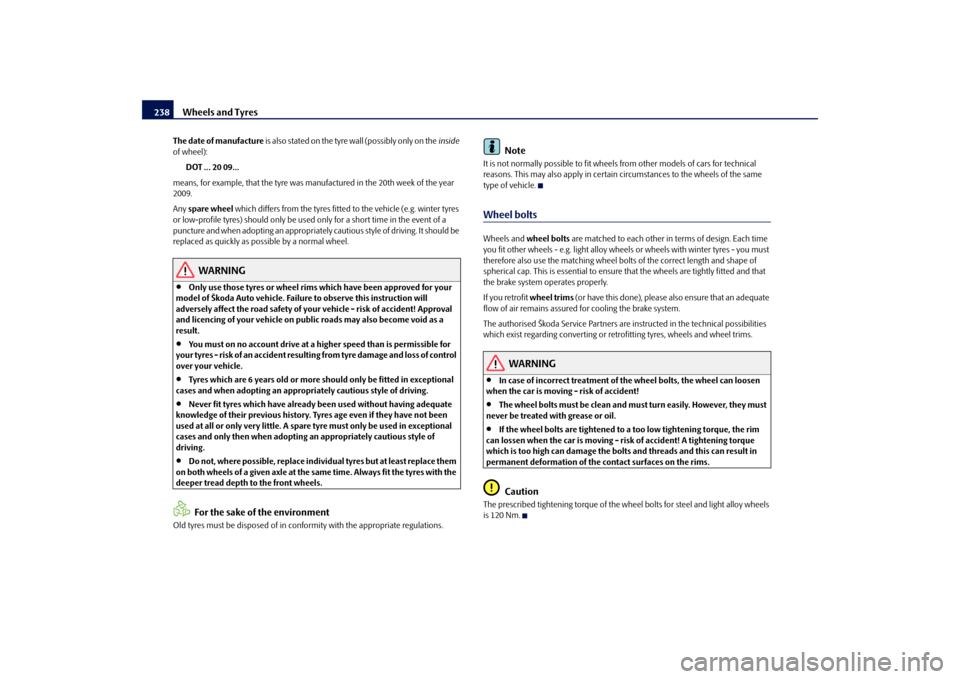
Wheels and Tyres
238
The date of manufacture
is a lso s tated on the tyre wal l (poss ibly o nl y on the
inside
of wheel):
DOT ... 20 09...
means, for example, that the tyre was manufactured in the 20th week of the year 2009. Any
spare wheel
which differs from the tyres fitted to the vehicle (e.g. winter tyres
or low-profile tyres) should only be used
only for a short time in the event of a
puncture and when adopting an appropriately
cautious style of driving. It should be
replaced as quickly as po
ssible by a normal wheel.
WARNING
•
Only use those tyres or wheel rims
which have been approved for your
model of Škoda Auto vehicle. Failure to observe this instruction will adversely affect the road safety of your vehicle - risk of accident! Approval and licencing of your vehicle on public roads may also become void as a result.•
You must on no account drive at a higher speed than is permissible for
y our t yre s - ris k of a n ac cid e n t re su lti ng fro m ty re d a m ag e a nd lo ss o f c ont rol over your vehicle.•
Tyres which are 6 years old or more should only be fitted in exceptional
cases and when adopting an appropriately cautious style of driving.•
Never fit tyres which have already been used without having adequate
knowledge of their previous history. Ty
res age even if they have not been
used at all or only very little. A spare tyre must only be used in exceptional cases and only then when adopting an appropriately cautious style of driving.•
Do not, where possible, replace indivi
dual tyres but at least replace them
on both wheels of a given axle at the same time. Always fit the tyres with the deeper tread depth to the front wheels.
For the sake of the environment
Old tyres must be disposed
of in conformity with the appropriate regulations.
Note
It is not normally possible to fit wheels
from other models of cars for technical
reasons. This may also apply in certain
circumstances to the wheels of the same
type of vehicle.Wheel boltsWheels and
wheel bolts
are matched to each other in
terms of design. Each time
you fit other wheels - e.g. light alloy wheels
or wheels with winter tyres - you must
therefore also use the matching wheel bolts of the correct length and shape of spherical cap. This is essent
ial to ensure that the wheels are tightly fitted and that
the brake system operates properly. If you retrofit
wheel trims
(or have this done), please also ensure that an adequate
flow of air remains assured for cooling the brake system. The authorised Škoda Service Partners are instructed in the technical possibilities which exist regarding converting or retrofitting tyres, wheels and wheel trims.
WARNING
•
In case of incorrect treatment of th
e wheel bolts, the
wheel can loosen
when the car is moving - risk of accident!•
The wheel bolts must be clean and must
turn easily. However, they must
never be treated with grease or oil.•
If the wheel bolts are tightened to a too low tightening torque, the rim
can lossen when the car is moving - risk of accident! A tightening torque which is too high can damage the bolts and threads and this can result in permanent deformation of the contact surfaces on the rims.
Caution
The prescribed tightening torque of the wh
eel bolts for steel and light alloy wheels
is 120 Nm.
s2dk.1.book Page 238 Wednesday, April 8, 2009 12:23 PM
Page 246 of 294

Breakdown assistance
245
Using the system
Safety
Driving Tips
General Maintenance
Breakdown assistance
Technical Data
Spare wheel*The spare wheel lies in a well under the floor covering of the luggage compartment and is fixed in place using special screws
⇒fig. 216
.
Before removing the spare wheel, you must take out the box with the vehicle tool kit box
⇒page 244, fig. 215
.
One should check the inflation pressure in the spare wheel (at best when generally checking the tyre air pressures - see sign on the fuel filler flap
⇒page 235) to
ensure that the spare wheel is always ready to use. Temporary spare wheel A warning label displayed on the rim of the temporary spare wheel indicates that your vehicle is equipped with a temporary spare wheel. Please observe the following notes when driving with a temporary spare wheel:•
After fitting on the wheel, the warning stic
ker must not be concealed (e.g. by the
wheel trim).•
Do not drive with this spare wheel at more than 80 km/h - risk of accident. Avoid
accelerating at full throttle, sharp braking and fast cornering.•
The inflation pressure for this spare wheel is identical to the inflation pressure
of the standard tyres. The temporary spare wheel R 18 must have an inflation pres-sure of 420 kPa (4.2 bar)!
•
Use this spare wheel only to reach the nearest specialist garage as it is not
intended for continuous use.•
No other summer or winter tyres must
be mounted on the rim of the spare
wheel R 18.Changing a wheelPreliminary workThe following steps should be carried out before actually changing the wheel. – If it is necessary to change a wheel, park the vehicle as far away as
possible from the traffic flow. The place you choose should be
level
.
–Have
all the occupants get out.
While changing a wheel, the occu-
pants of the vehicle should not stan
d on the road (e.g. behind a crash
barrier).
– Apply the
handbrake
firmly.
–Engage
1st gear
or if your vehicle is fitted with an automatic gearbox,
position the
selector lever into position P
.
– If a trailer is coupled, uncouple it. – Take the
vehicle tool kit
⇒
page 244 and the
spare wheel
⇒
page 245 out of the luggage compartment.WARNING
•
If you find yourself in flowing traffic switch on the hazard warning lights
system and place the warning triangle
on the side of the road at the
prescribed distance from
your vehicle while obse
rving all national legal
provisions. In this way you are protecting not only yourself but also other road users.
Fig. 216 Luggage compart- ment: Spare wheel
s2dk.1.book Page 245 Wednesday, April 8, 2009 12:23 PM
Page 247 of 294
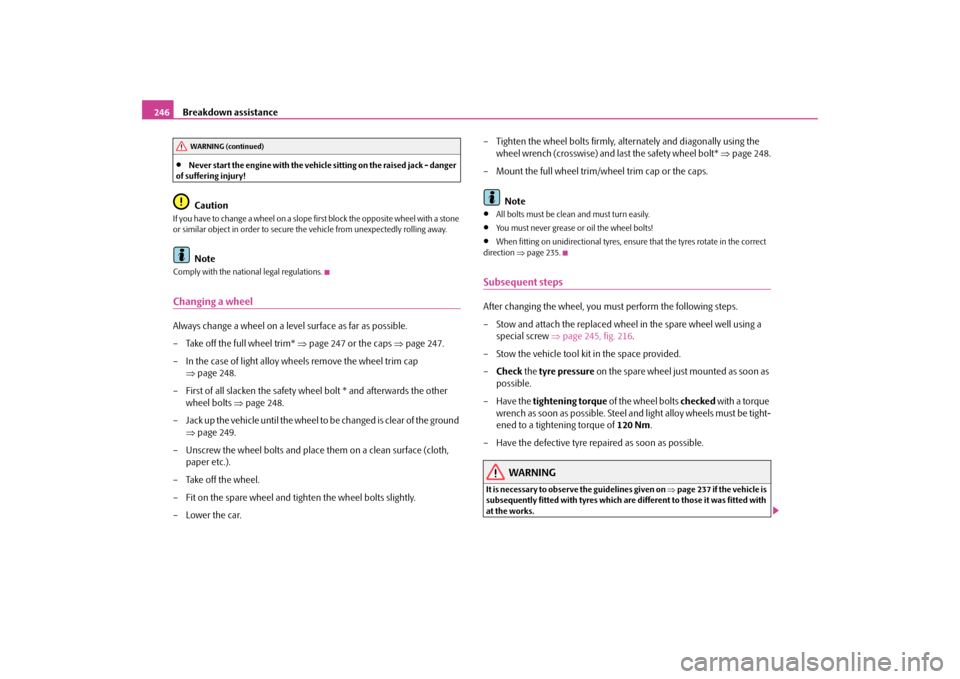
Breakdown assistance
246
•
Never start the engine with the vehicle
sitting on the raised jack - danger
of suffering injury!
Caution
If you have to change a wheel on a slope
first block the opposite wheel with a stone
or similar object in order to secure th
e vehicle from unexpectedly rolling away.
Note
Comply with the national legal regulations.Changing a wheelAlways change a wheel on a level surface as far as possible. – Take off the full wheel trim*
⇒
page 247 or the caps
⇒
page 247.
– In the case of light alloy wheels remove the wheel trim cap
⇒
page 248.
– First of all slacken the safety wh
eel bolt * and afterwards the other
wheel bolts
⇒
page 248.
– Jack up the vehicle until the wheel to
be changed is clear of the ground
⇒
page 249.
– Unscrew the wheel bolts and place them on a clean surface (cloth,
paper etc.).
– Take off the wheel. – Fit on the spare wheel and tighten the wheel bolts slightly. –Lower the car.
– Tighten the wheel bolts firmly, al
ternately and diagonally using the
wheel wrench (crosswise) and last the safety wheel bolt*
⇒
page 248.
– Mount the full wheel trim/w
heel trim cap or the caps.
Note
•
All bolts must be clean
and must turn easily.
•
You must never grease or oil the wheel bolts!
•
When fitting on unidirectional tyres, ensure that the tyres rotate in the correct
direction
⇒page 235.
Subsequent stepsAfter changing the wheel, you must perform the following steps. – Stow and attach the replaced wheel in the spare wheel well using a
special screw
⇒
page 245, fig. 216
.
– Stow the vehicle tool kit in the space provided.–
Check
the
tyre pressure
on the spare wheel just mounted as soon as
possible.
– Have the
tightening torque
of the wheel bolts
checked
with a torque
wrench as soon as possible. Steel and light alloy wheels must be tight-ened to a tightening torque of
120 Nm
.
– Have the defective tyre repaired as soon as possible.
WARNING
It is necessary to observe the guidelines given on
⇒page 237 if the vehicle is
subsequently fitted with tyres which are
different to those it was fitted with
at the works.
WARNING (continued)
s2dk.1.book Page 246 Wednesday, April 8, 2009 12:23 PM
Page 249 of 294
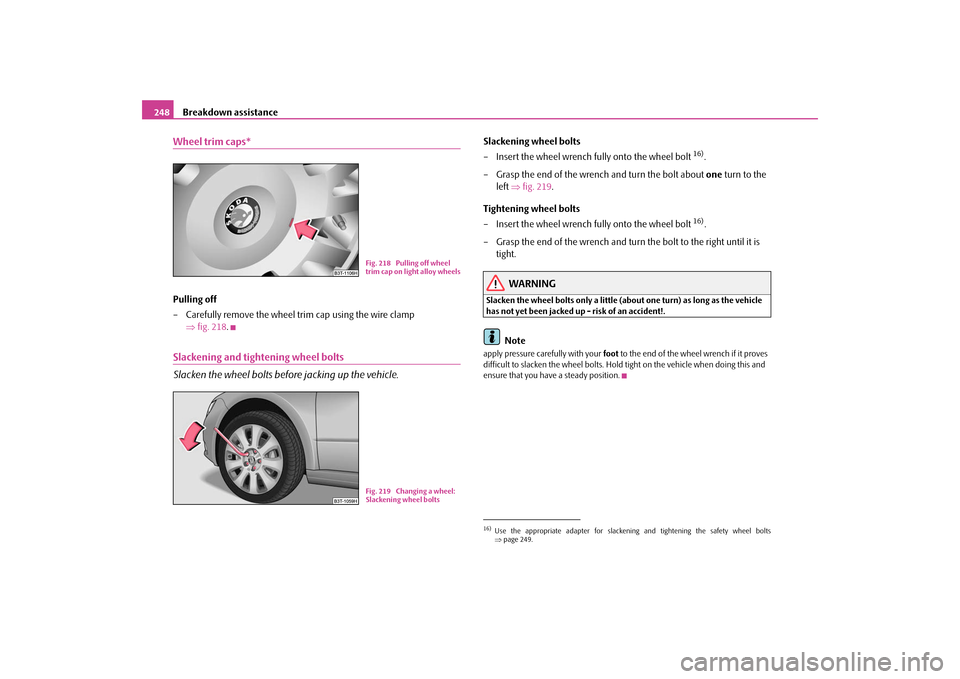
Breakdown assistance
248
Wheel trim caps*Pulling off – Carefully remove the wheel tr
im cap using the wire clamp
⇒
fig. 218
.
Slackening and tightening wheel bolts Slacken the wheel bolts before jacking up the vehicle.
Slackening wheel bolts – Insert the wheel wrench fully onto the wheel bolt
16).
– Grasp the end of the wrench and turn the bolt about
one
turn to the
left
⇒
fig. 219
.
Tightening wheel bolts – Insert the wheel wrench fully onto the wheel bolt
16).
– Grasp the end of the wrench and turn the bolt to the right until it is
tight.
WARNING
Slacken the wheel bolts only a little (a
bout one turn) as long as the vehicle
has not yet been jacked up - risk of an accident!.
Note
apply pressure carefully with your
foot
to the end of the wheel wrench if it proves
difficult to slacken the wheel bolts. Hold tight on the vehicle when doing this and ensure that you have a steady position.
Fig. 218 Pulling off wheel trim cap on light alloy wheelsFig. 219 Changing a wheel: Slackening wheel bolts
16)Use the appropriate adapter for slackening
and tightening the safety wheel bolts
⇒ page 249.
s2dk.1.book Page 248 Wednesday, April 8, 2009 12:23 PM
Page 251 of 294
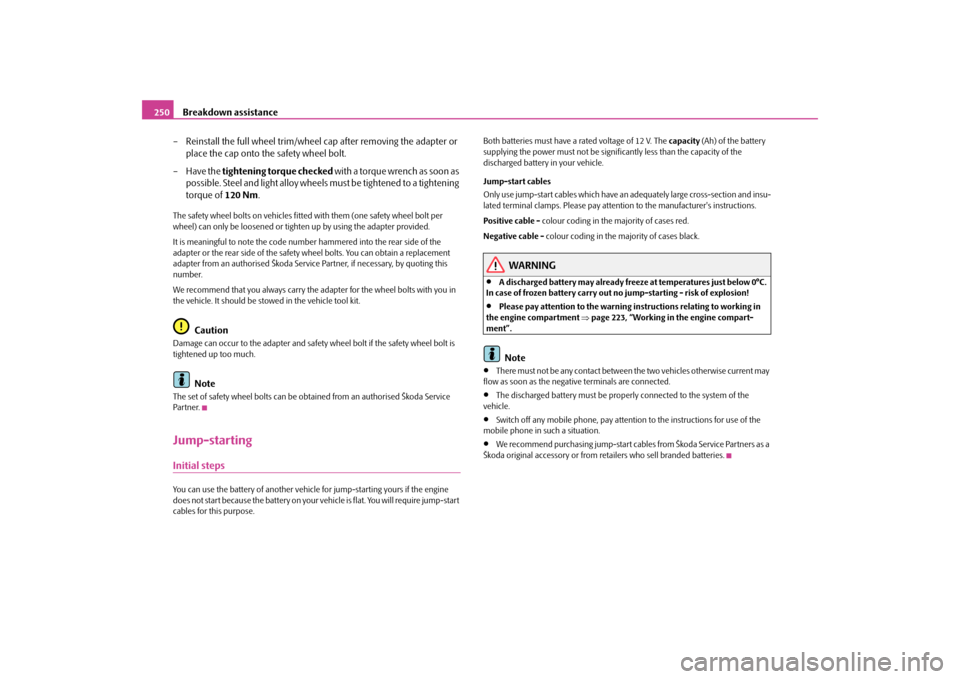
Breakdown assistance
250
– Reinstall the full wheel trim/wheel cap after removing the adapter or
place the cap onto the safety wheel bolt.
– Have the
tightening torque
checked
w i t h a t o rq u e w re n c h a s s o o n a s
possible. Steel and light alloy wheels must be tightened to a tightening torque of
120 Nm
.
The safety wheel bolts on vehicles fitted with them (one safety wheel bolt per wheel) can only be loosened or tigh
ten up by using the adapter provided.
It is meaningful to note the code numbe
r hammered into the rear side of the
adapter or the rear side of the safety wheel bolts. You can obtain a replacement adapter from an authorised Škoda Service Partner, if necessary, by quoting this number. We recommend that you always carry the
adapter for the wheel bolts with you in
the vehicle. It should be st
owed in the vehicle tool kit.
Caution
Damage can occur to the adapter and safety
wheel bolt if the safety wheel bolt is
tightened up too much.
Note
The set of safety wheel bolts can be obta
ined from an authorised Škoda Service
Par tner.Jump-startingInitial stepsYou can use the battery of another vehicl
e for jump-starting yours if the engine
does not start because the battery on your
vehicle is flat. You will require jump-start
cables for this purpose.
Both batteries must have a rated voltage of 12 V. The
capacity
(Ah) of the battery
supplying the power must not be signific
antly less than the capacity of the
discharged battery
in your vehicle.
Jump-start cables Only use jump-start cables which have an
adequately large cross-section and insu-
lated terminal clamps. Please pay attent
ion to the manufacturer's instructions.
Positive cable -
colour coding in the
majority of cases red.
Negative cable -
colour coding in the majority of cases black.
WARNING
•
A discharged battery may already freeze
at temperatures just below 0°C.
In case of frozen battery carry out no jump-starting - risk of explosion!•
Please pay attention to the warning instructions relating to working in
the engine compartment
⇒page 223, “Working in the engine compart-
ment”.
Note
•
There must not be any contact between the two vehicles otherwise current may
flow as soon as the negative terminals are connected.•
The discharged battery must be proper
ly connected to the system of the
vehicle.•
Switch off any mobile phone, pay attent
ion to the instructions for use of the
mobile phone in such a situation.•
We recommend purchasing jump-start cabl
es from Škoda Service Partners as a
Škoda original accessory or from retailers who sell branded batteries.
s2dk.1.book Page 250 Wednesday, April 8, 2009 12:23 PM
Page 253 of 294
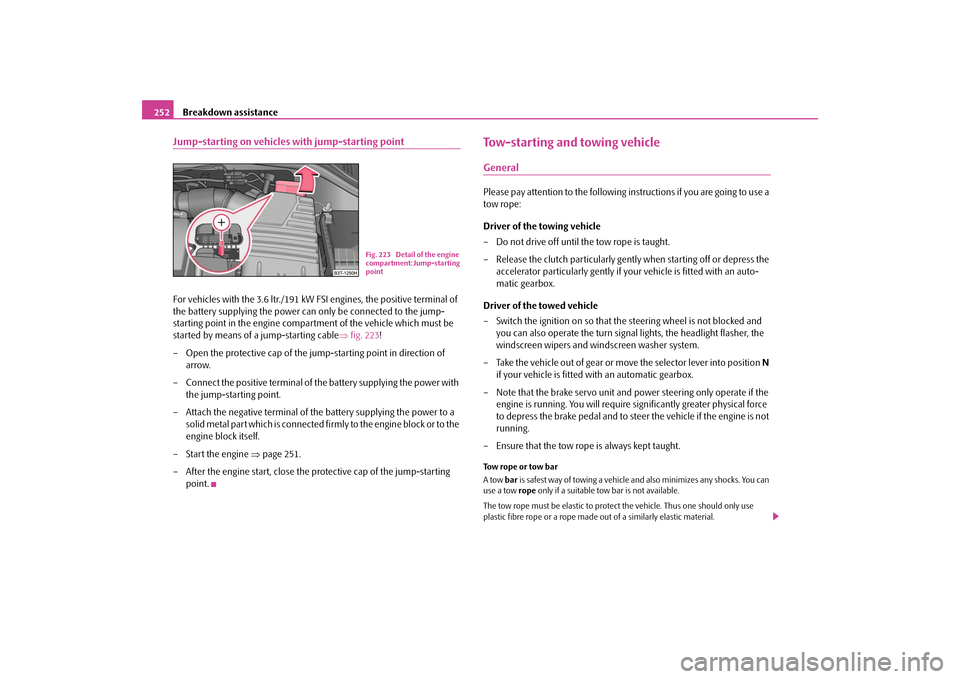
Breakdown assistance
252
Jump-starting on vehicles with jump-starting pointFor vehicles with the 3.6 ltr./191 kW FS
I engines, the positive terminal of
the battery supplying the power can only be connected to the jump-starting point in the engine compartment of the vehicle which must be started by means of a jump-starting cable
⇒
fig. 223
!
– Open the protective cap of the ju
mp-starting point in direction of
arrow.
– Connect the positive terminal of
the battery supplying the power with
the jump-starting point.
– Attach the negative terminal of the battery supplying the power to a
solid metal part which is connected fi
rmly to the engine block or to the
engine block itself.
–Start the engine
⇒
page 251.
– After the engine start, close the
protective cap of the jump-starting
point.
Tow-starting and towing vehicleGeneralPlease pay attention to the following in
structions if you are going to use a
tow rope: Driver of the towing vehicle – Do not drive off until the tow rope is taught. – Release the clutch particularly gent
ly when starting off or depress the
accelerator particularly gently if yo
ur vehicle is fitted with an auto-
matic gearbox.
Driver of the towed vehicle – Switch the ignition on so that th
e steering wheel is not blocked and
you can also operate the turn signal
lights, the headlight flasher, the
windscreen wipers and windscreen washer system.
– Take the vehicle out of gear or move the selector lever into position
N
if your vehicle is fitted
with an automatic gearbox.
– Note that the brake servo unit and po
wer steering only operate if the
engine is running. You will require
significantly greater physical force
to depress the brake pedal and to steer the vehicle if the engine is not running.
– Ensure that the tow rope is always kept taught.Tow rope or tow bar A tow
bar
is safest way of towing a vehicle and also minimizes any shocks. You can
use a tow
rope
only if a suitable tow bar is not available.
The tow rope must be elastic to protect
the vehicle. Thus one should only use
plastic fibre rope or a rope made
out of a similarly elastic material.
Fig. 223 Detail of the engine compartment: Jump-starting point
s2dk.1.book Page 252 Wednesday, April 8, 2009 12:23 PM
Page 257 of 294
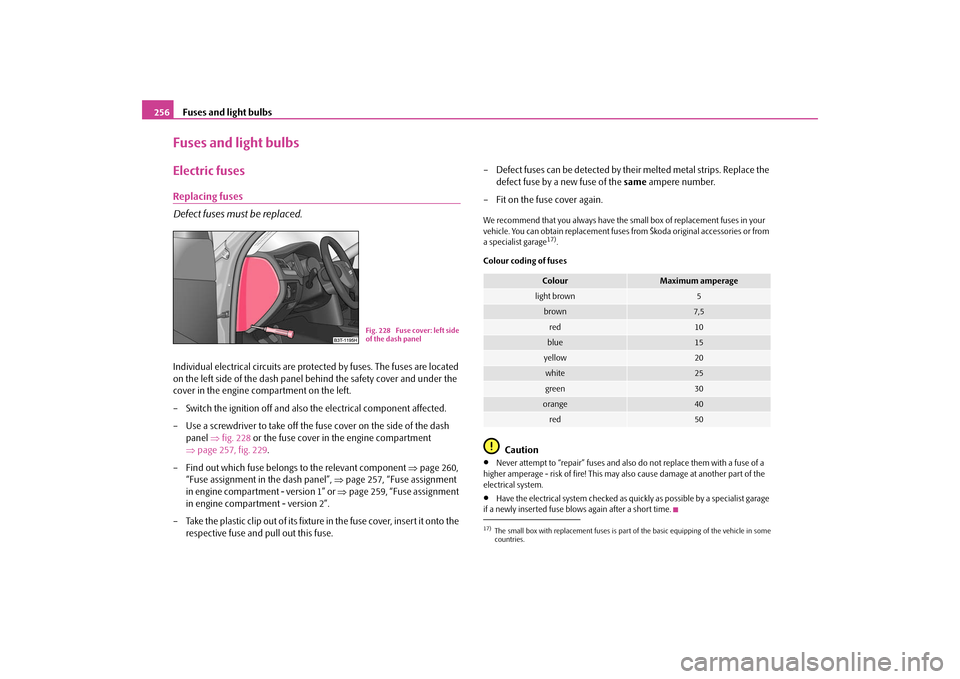
Fuses and light bulbs
256
Fuses and light bulbsElectric fusesReplacing fuses Defect fuses must be replaced.Individual electrical circuits are prot
ected by fuses. The fuses are located
on the left side of the dash panel behind the safety cover and under the cover in the engine compartment on the left. – Switch the ignition off and also the electrical component affected.– Use a screwdriver to take off the fuse cover on the side of the dash
panel
⇒
fig. 228
or the fuse cover in the engine compartment
⇒
page 257, fig. 229
.
– Find out which fuse belongs to the relevant component
⇒
page 260,
“Fuse assignment in the dash panel”,
⇒
page 257, “Fuse assignment
in engine compartment - version 1” or
⇒
page 259, “Fuse assignment
in engine compartment - version 2”.
– Take the plastic clip out of its fixture in the fuse cover, insert it onto the
respective fuse and pull out this fuse.
– Defect fuses can be detected by th
eir melted metal st
rips. Replace the
defect fuse by a new fuse of the
same
ampere number.
– Fit on the fuse cover again.We recommend that you always have the
small box of replacement fuses in your
vehicle. You can obtain replacement fuses from Škoda original accessories or from a specialist garage
17).
Colour coding of fuses
Caution
•
Never attempt to “repair” fuses and also do not replace them with a fuse of a
higher amperage - risk of fire! This may
also cause damage at another part of the
electrical system.•
Have the electrical system checked as quickly as possible by a specialist garage
if a newly inserted fuse blows again after a short time.
Fig. 228 Fuse cover: left side of the dash panel
17)The small box with replacement fuses is part of the basic equipping of the vehicle in somecountries.
Colour
Maximum amperage
light brown
5
brown
7,5
red
10
blue
15
yellow
20
white
25
green
30
orange
40
red
50
s2dk.1.book Page 256 Wednesday, April 8, 2009 12:23 PM
Page 258 of 294
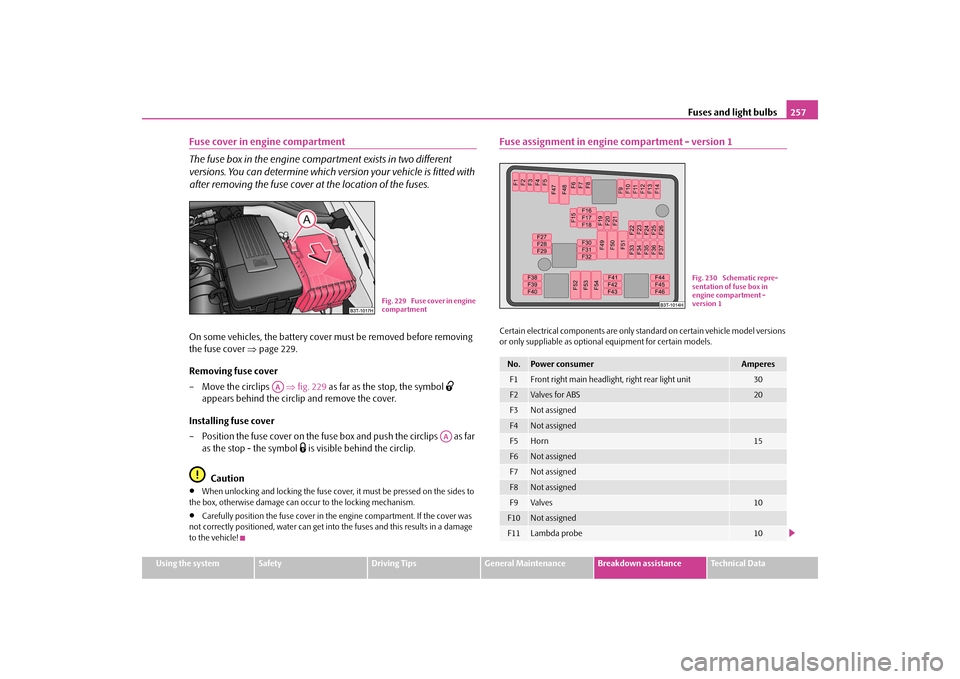
Fuses and light bulbs
257
Using the system
Safety
Driving Tips
General Maintenance
Breakdown assistance
Technical Data
Fuse cover in engine compartment The fuse box in the engine comp
artment exists in two different
versions. You can determine which version your vehicle is fitted with after removing the fuse cover at the location of the fuses.On some vehicles, the battery cover
must be removed before removing
the fuse cover
⇒
page 229.
Removing fuse cover – Move the circlips
⇒
fig. 229
as far as the stop, the symbol
appears behind the circlip and remove the cover.
Installing fuse cover – Position the fuse cover on the fuse box and push the circlips as far
as the stop - the symbol
is visible behind the circlip.
Caution
•
When unlocking and locking the fuse cover,
it must be pressed on the sides to
the box, otherwise damage can
occur to the locking mechanism.
•
Carefully position the fuse cover in th
e engine compartment. If the cover was
not correctly positioned, water can get into
the fuses and this results in a damage
to the vehicle!
Fuse assignment in engine compartment - version 1Certain electrical components are only standard on certain vehicle model versions or only suppliable as optional
equipment for certain models.
Fig. 229 Fuse cover in engine compartment
AA
AA
No.
Power consumer
Amperes
F1
Front right main headlight, right rear light unit
30
F2
Valves for ABS
20
F3
Not assigned
F4
Not assigned
F5
Horn
15
F6
Not assigned
F7
Not assigned
F8
Not assigned
F9
Valves
10
F10
Not assigned
F11
Lambda probe
10
Fig. 230 Schematic repre-sentation of fuse box in engine compartment - version 1
s2dk.1.book Page 257 Wednesday, April 8, 2009 12:23 PM